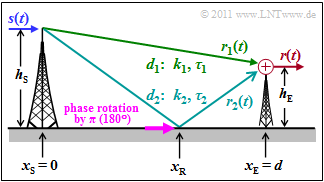Exercise 2.2Z: Real Two-Path Channel
Aus LNTwww
Version vom 11. Mai 2020, 16:10 Uhr von Guenter (Diskussion | Beiträge)
The sketched scenario is considered in which the transmitted signal s(t) reaches the antenna of the receiver via two paths: r(t) = r1(t)+r2(t)=k1⋅s(t−τ1)+k2⋅s(t−τ2).
Note the following:
- The delays τ1 and τ2 of the main and secondary paths can be calculated from the path lengths d1 and d2 using the speed of light c=3⋅108 m/s .
- The amplitude factors k1 and k2 are obtained according to the path loss model with path loss exponent γ=2 (free-space attenuation).
- The height of the transmit antenna is hS=500 m. The height of the receiving antenna is hE=30 m. The antennas are separated by a distance of d=10 km.
- The reflection on the secondary path causes a phase change of π, so that the partial signals must be subtracted. This is taken into account by a negative k2 value.
Note:
- This task belongs to the chapter Mehrwegeempfang beim Mobilfunk.
Questionnaire
Sample solution
(1) According to Pythagoras:
d1=√d2+(hS−hE)2=√102+(0.5−0.03)2km=10011.039m_.
- Actually, specifying such a length with an accuracy of one millimeter is not very useful and contradicts the mentality of an engineer.
- We have done this anyway to be able to check the accuracy of the approximation in subtask 4 (4).
(2) If you fold the reflected beam on the right side of xR downwards (reflection on the ground), you get again a right triangle. From this follows: d2=√d2+(hS+hE)2=√102+(0.5+0.03)2km=10014.035m_.
(3) Using the results from (1) and (2), the length and delay differences are:
- Δd=d2−d1==2.996m_,Δτ=Δdc=2.996m3⋅108m/s=9.987ns_.
(4) With hS+hE≪d the above equation can be expressed as follows:
- d1 = d⋅√1+(hS−hE)2d2≈d⋅[1+(hS−hE)22d2],d2 = d⋅√1+(hS+hE)2d2≈d⋅[1+(hS+hE)22d2]
- ⇒Δd=d2−d1≈12d⋅[(hS+hE)2−(hS−hE)2]=2⋅hS⋅hEd⇒Δτ=Δdc≈2⋅hS⋅hEc⋅d.
- So the correct solution is the solution 3. With the given numerical values, we have
- Δτ≈2⋅500m⋅30m3⋅108m/s⋅10000m=10−8s=10ns.
- The relative error with respect to the actual value according to the subtask '(3) is only 0.13%.
- In solutions 1 and 2, the dimensions are wrong.
- In solution 2, there would be no propagation delay if both antennas were the same height. This is clearly not true.
(5) The path loss exponent γ=2 implies that the reception power PE decreases quadratically with distance.
- The signal amplitude thus decreases with 1/d, so for some constant K we have
- k1=Kd1,|k2|=Kd2⇒|k2|k1=d1d2=10011,039m10014,035m≈0.99.
- The two path weights thus only differ in magnitude by about 1%.
- In addition, the coefficients k1 and k2 have different signs ⇒ Answers 1 and 3 are correct.
